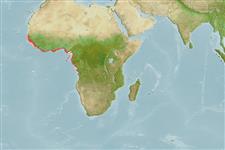Environment: milieu / climate zone / depth range / distribution range
Ecology
Marine; brackish; demersal; depth range ? - 100 m (Ref. 26999), usually ? - 50 m (Ref. 57293). Tropical; 30°N - 14°S, 18°W - 13°E (Ref. 5222)
Eastern Atlantic: Senegal to Lobito, Angola, including the Canary Islands (Tenerife).
Size / Weight / Age
Maturity: Lm ? range ? - ? cm
Max length : 30.5 cm TL male/unsexed; (Ref. 57293); common length : 20.0 cm TL male/unsexed; (Ref. 26999)
Dorsal spines (total): 9; Dorsal soft rays (total): 14 - 15; Anal spines: 3; Anal soft rays: 8. Diagnosis: depth of body 2.8-3.0 in SL; head length 2.5-2.6 in SL; eye diameter greater than interorbital width, eye diameter 4.6-5.5 in HL; flat interorbital area; rounded preopercle, finely serrate, lower edge fleshy; subopercle and interopercle smooth; convex upper edge of operculum; maxilla scaly, reaching well past eye; lateral-body scales ctenoid, without auxiliary scales (Ref. 89707).
Occurs on mud (Ref. 5222), sand, and rock bottoms (Ref. 5222, 57293) in coastal waters, usually above 50 m depth (Ref. 57293). Exceptionally enters brackish lagoons and estuaries (Ref. 57293).
Life cycle and mating behavior
Maturities | Reproduction | Spawnings | Egg(s) | Fecundities | Larvae
Heemstra, P.C. and J.E. Randall, 1993. FAO Species Catalogue. Vol. 16. Groupers of the world (family Serranidae, subfamily Epinephelinae). An annotated and illustrated catalogue of the grouper, rockcod, hind, coral grouper and lyretail species known to date. Rome: FAO. FAO Fish. Synop. 125(16):382 p. (Ref. 5222)
IUCN Red List Status (Ref. 130435)
Threat to humans
Harmless
Human uses
Fisheries: of no interest
Tools
Special reports
Download XML
Internet sources
Estimates based on models
Preferred temperature (Ref.
123201): 19.2 - 27.9, mean 25.8 °C (based on 80 cells).
Phylogenetic diversity index (Ref.
82804): PD
50 = 0.5000 [Uniqueness, from 0.5 = low to 2.0 = high].
Bayesian length-weight: a=0.01259 (0.00590 - 0.02687), b=3.04 (2.87 - 3.21), in cm total length, based on LWR estimates for this Genus-body shape (Ref.
93245).
Trophic level (Ref.
69278): 4.0 ±0.7 se; based on size and trophs of closest relatives
Resilience (Ref.
120179): Medium, minimum population doubling time 1.4 - 4.4 years (Preliminary K or Fecundity.).
Fishing Vulnerability (Ref.
59153): Low vulnerability (21 of 100).
